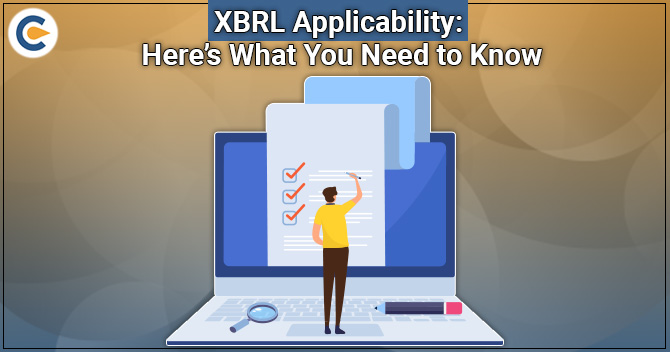XBRL refers to the data-rich language of XML, the standard dialect for transmitting data via the internet. It was developed to share information between companies and other users of finance-related information such as investors, analysts, and regulators. XBRL facilitates a common, digital format for business reporting. It does not alter or modify what is being reported. It only deals with the presentation aspect of the reports.
XBRL is a standard dialect developed by XBRL International Inc. (XII), a non-profit making consortium backed by hundreds of members, including government institutions, accounting agencies, software firms, small and large companies, academics, and business reporting experts. XBRL International Inc has agreed on the fundamental specifications that define how XBRL functions.
What is the role of XBRL tags?
In XBRL, information is not considered as a static block of text or group of no. Instead, the information is bifurcated into unique items of data (eg total liabilities = 200). Further, these items of data are then assigned mark-up tags that are readable to the computers.
For instance, the tag <Liabilities>200</Liabilities> enables the system to fetch that the item is liabilities, and it has a value of 200. Systems can compile information that has been tagged leveraging XBRL ‘intelligently’; they can identify, process, store, & analyze it via software.
Because XBRL tags are created in a globally-accepted way, they can be easily fetched and complied by any system via XBRL software. Such tags are defined & organized via categorization schemes known as taxonomies
A Brief Overview
Most nations leverage different accounting standards that reflect differing reporting definitions. The XBRL language takes advantage of different dictionaries, called ‘taxonomies’, to sets out the specific tags used for each standard. Each dictionary may define different objectives and types of reporting.
Taxonomies refer to system-readable ‘dictionaries’ of XBRL. Taxonomies render definitions for XBRL tags, they facilitate detail about the tags and they organize the same so that they have a logical structure.
Consequently, taxonomies enable systems with XBRL software to fetch:
- what is tag is (ex: whether it is text, %, or a monetary item)
- what the tag has (ex: if it adheres to a negative value);
- its relationship to other items (ex: if it is part of a calculation).
Technically, such information is regarded as meta-data. When the XBRL-tagged information is transmitted, the meta-data assigned within the tags is also transmitted. Taxonomies vary as per reporting objectives, the type of information being reported & reporting presentation requisites.
As a result, an organization may utilize one taxonomy while reporting to the stock exchange, but utilize a different taxonomy while reporting to a specific regulator. Taxonomies are accessible to most of the national accounting standards globally.
How does XBRL function in general?
XBRL is a dialect of Extensive Markup language, aka XML, which is standard for the digital sharing of information between entities and on the internet. Under XML, identifying tags are applied to items of data so that they can be processed efficiently by computer software.
It is an advanced version of XML which has been defined to cater to the requirements of financial and business information. It enables distinctive tags to be applied to items of financial information, such as ‘net profit’.
Apart from being simple identifiers, they serve other purposes as well. They facilitate a range of information relating to the item, such as whether it fraction, %, or monetary item. It allows labels in any language to be assigned to items and accounting references or subsidiary information.
XBRL can manifest how items are connected. It can therefore manifest how they are computed. Moreover, It is easily extensible, so entities & other firms can adapt it to fulfill a variety of special requirements.
It ensures seamless and efficient handling of business data via system software. It bolsters all the standard activities involved in fetching, storing, and compiling business data. This information can be transformed into XBRL via apt mapping processes or generated in XBRL via software. It can then be easily, searched, selected, shared or analyzed by the system, or published for ordinary viewing.
XBRL Applicability under Companies Act, 2013
It is a well-known fact that the provisions of the Companies Act, 2013[1] and rules underpinned thereunder, mandate entities to file compulsory documents, including financial statements and yearly returns, with the respective RoC of their jurisdiction.
The said Act mandates company to file its annual returns and annual accounts within 60 and 30 days respectively from the conclusion of the AGM i.e. Annual General Meeting. Filing of annual accounts is regulated u/s 137 of the Act, 2013 read with Rule 12 of the Company (Accounts) Rules, 2014 & yearly return is regulated u/s 92 of the Act, 2013 read with Rule 11 of the Companies (Management & Administration) Rules, 2014.
According to Section 137 of the Companies Act, 2013, incorporated entities are mandated to file their audited financial statement via form AOC-4 within thirty days of AGM. There are different types of forms prescribed for different companies’ classes. Besides, the given classes of companies are obligated to disclose their financial reports in extensible business reporting language (XBRL).
|
Sr. No |
Company Types |
Applicable taxonomy |
|
1. |
Companies on stock exchanges in India & their Indian subsidiaries |
IndAS |
|
2 |
Companies with paid-up capital of Rs 5 crores or above |
C&I |
|
3 |
Companies with yearly turnover of Rs 100 crores or above |
C&I |
|
4 |
All companies which are obligated to prepare their financial statements as per Companies (Indian Accounting Standards) Rules, 2015 |
IndAS |
However, given entities are not required to file financial statements in XBRL:
- Non-banking financial companies (NBFCs)
- Housing finance companies (HFCs)
- Banking Companies
- Insurance-based Companies
Note that OPCs are mandated to file financial statements within 180 days from the completion of the FY.
Underlying Benefits
- XBRL facilitates potential benefits at all phases of business reporting as well as analysis. The benefits are noticeable in cost-saving, automation, accurate data handling, improved analysis, and better quality of information.
- All types of companies can leverage XBRL to ensure cost-saving and improve efficacy in handling business & financial data.
- Because XBRL is extensible, it can be applied to a wide range of different requisites.
- XBRL enables producers and users of financial information to mobilize resources away from tedious and manual processes, generally involving time-consuming comparison, collection, and re-entry of data. They can lay more emphasis on analysis, aided by software that can verify and compile XBRL information.
- By using XBRL, different organizations and other generators of financial information and business reporting can automate the processes of data collection.
- Government agencies and regulators can assemble, verify and examine data much more seamlessly and accurately when compared to previous working frameworks.
- XBRL software is spot on when it comes to prompt validation of data, error identification, and mitigation.
Conclusion
Technically, XBRL refers to a structured way of digital reporting which enables information’s tagging into a machine-readable format. As this has countless benefits for entities and regulators’ reporting processes, XBRL is becoming the standalone standard for electronic reporting globally.
Read our article:Circulation of member resolution: Everything you need to know











